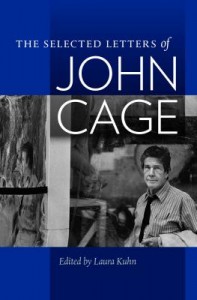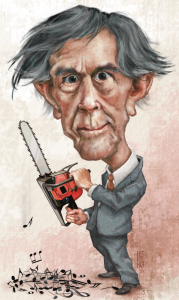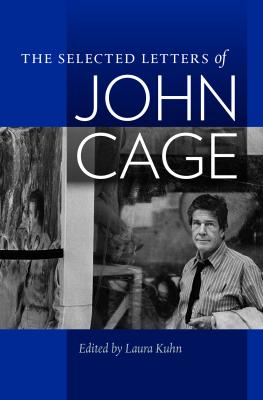 The Selected Letters of John Cage
The Selected Letters of John Cage
Edited by Laura Kuhn
Wesleyan U. Press. 651 pages, $40
ONE OF THE MOST eclectic artists of the 20th century was avant-garde composer John Cage, who was also a philosopher, a visual artist, and a writer. Cage transformed modernist æsthetics with his embrace of randomness, chance operations, and early adoption of technology in his artistic practice. And silence: in his composition 4’33” (1952), musicians sit in silence and do not intentionally make sounds for four minutes and 33 seconds.
My path crossed with John Cage’s a few times. Once, while I was on tour in the mid-1980s with the Trisha Brown Dance Company in France, I sat in a hotel lobby with him and watched the French Open on television, and then shared a taxi with him to the theater. On the drive over, he repeatedly cranked the car window up and down, amused by its squeaky sounds.
In 1990, when I worked at the Walker Art Center, I invited Cage to do a reading to celebrate the opening of the Jasper Johns: Printed Symbols exhibition. He had written about Johns earlier in his career, and for this performance he randomly rearranged his text utilizing his computer, and presented the resulting concatenation. We had gotten a request for ASL interpretation. Cage was concerned, warning the interpreter that the speech did not really make any linear sense. During his performance, he repeatedly stopped and watched the interpreter, who, of course, also stopped. The bemused Cage then continued reading. Afterward, Margaret Leng Tan performed some of Cage’s compositions on a toy piano.
 While his public artistic persona was expansive, Cage was reticent about his private life. When asked about his relationship with his life partner, the great choreographer Merce Cunningham, he would often politely reply: “I do the cooking, and he does the dishes.” While openly gay, neither of them chose to discuss their homosexuality publicly.
While his public artistic persona was expansive, Cage was reticent about his private life. When asked about his relationship with his life partner, the great choreographer Merce Cunningham, he would often politely reply: “I do the cooking, and he does the dishes.” While openly gay, neither of them chose to discuss their homosexuality publicly.
However, The Selected Letters of John Cage, which includes more than 500 letters, brings readers intimately into his personal life, beginning in the 1930s, when he was a seventeen-year-old dropout traveling in Europe and Algeria, to shortly before his death in 1992. His affable nature resonates throughout this luminous collection and gives the reader insight into his prodigious intellectual and artistic pursuits. We read his pleas as a fledgling music student to study with Arnold Schoenberg, acquire expertise on Erik Satie and Virgil Thomson’s music, and build relationships with Morton Feldman, Lou Harrison, Henry Cowell, and other emerging mavericks. These composers performed each others’ works in concert and often wrote about each other, since few critics understood the new æsthetic frontiers they were exploring.
Frustration is present in Cage’s missives to orchestra and museum directors around the world as he struggles to earn a living and be taken seriously as a composer. For decades, he was his own booking agent and personally asked people to help underwrite his concerts. He struggled valiantly to establish a center for new music at Cornish School, Bennington College, and Mills College—all to no avail. Tellingly, he wrote to young a composer: “I never made enough money [from my music]to live on until I was fifty. Interrupted my music in order to do odd jobs in order to eat, etc.”
Throughout his life, Cage remained a cultural omnivore. Interwoven into Selected Letters are comments that reveal how his life and art were informed by his study of the I Ching and Zen Buddhism, his burgeoning interest in mushrooms (making him an amateur mycologist), and his embrace of a macrobiotic diet. He aspired to have “all distinctions between art and life removed.” His blending of Eastern and Western artistic traditions placed him at the center of the American avant-garde of the 1950s and ’60s.
Cage’s early notes to Merce Cunningham are beautifully innocent. “I think of you all the time and therefore have little to say that would not embarrass you, for instance my first feeling about the rain was that it was like you. … I would like to measure my breath in relation to the air between us.” Cage became musical director for the Merce Cunningham Dance Company, and together they disrupted prevailing notions of modern music and dance. Aiding their revolution were visual artists Jasper Johns and Robert Rauschenberg, often collaborators on scenic and costume elements.
These relationships, and the masterpieces they created, are gloriously annotated throughout the book. And Cage did so much more than music for the Cunningham dance company. Early letters show him writing to festival promoters to book engagements, sending fundraising appeals to donors and funding agencies, and pleading with fellow artists to donate artwork to make up shortfalls from touring.
Cage’s persistence, entrepreneurship, and unequivocal questioning of the status quo could serve as inspiration for today’s artists who are struggling to forge a career. Ever the anarchist, Cage stated: “I think my activity in the arts is analogous to political activity. It gives an instance of how to change things radically.” The letters in this volume illuminate his creative processes and shed light on how he became a multifaceted artist who has influenced several generations of composers and other artists.
John R. Killacky is executive director of the Flynn Center for the Performing Arts in Burlington, VT.






